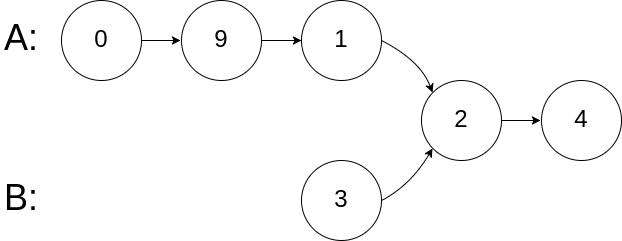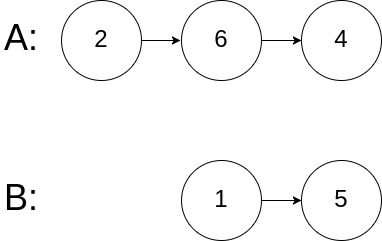160. Intersection of Two Linked Lists (Easy)
https://leetcode.com/problems/intersection-of-two-linked-lists/
Write a program to find the node at which the intersection of two singly linked lists begins.
For example, the following two linked lists:

begin to intersect at node c1.
Example 1:

Input: intersectVal = 8, listA = [4,1,8,4,5], listB = [5,0,1,8,4,5], skipA = 2, skipB = 3 Output: Reference of the node with value = 8 Input Explanation: The intersected node's value is 8 (note that this must not be 0 if the two lists intersect). From the head of A, it reads as [4,1,8,4,5]. From the head of B, it reads as [5,0,1,8,4,5]. There are 2 nodes before the intersected node in A; There are 3 nodes before the intersected node in B.
Example 2:

Input: intersectVal = 2, listA = [0,9,1,2,4], listB = [3,2,4], skipA = 3, skipB = 1 Output: Reference of the node with value = 2 Input Explanation: The intersected node's value is 2 (note that this must not be 0 if the two lists intersect). From the head of A, it reads as [0,9,1,2,4]. From the head of B, it reads as [3,2,4]. There are 3 nodes before the intersected node in A; There are 1 node before the intersected node in B.
Example 3:

Input: intersectVal = 0, listA = [2,6,4], listB = [1,5], skipA = 3, skipB = 2 Output: null Input Explanation: From the head of A, it reads as [2,6,4]. From the head of B, it reads as [1,5]. Since the two lists do not intersect, intersectVal must be 0, while skipA and skipB can be arbitrary values. Explanation: The two lists do not intersect, so return null.
Notes:
- If the two linked lists have no intersection at all, return
null. - The linked lists must retain their original structure after the function returns.
- You may assume there are no cycles anywhere in the entire linked structure.
- Your code should preferably run in O(n) time and use only O(1) memory.
Solutions
class Solution {
// This problem is easy to solve. The key point is to figure out the length of both list.
// It's clear that once both list move forward simultaneous, only if they have same length
// so that they can meet at the intersect node. The trick is that we can let the longer one
// move several steps in advance before both set off. The advanced steps should be the
// difference of the longer deducting the shorter. Now they are at the same start line and
// the distance to intersect node is the same.
public ListNode getIntersectionNode(ListNode headA, ListNode headB) {
if (headA == null || headB == null) {
return null;
}
int lenA = length(headA);
int lenB = length(headB);
ListNode ptrA = headA;
ListNode ptrB = headB;
while (lenA > lenB) {
ptrA = ptrA.next;
lenA--;
}
while (lenB > lenA) {
ptrB = ptrB.next;
lenB--;
}
while (ptrA != null && ptrB != null) {
if (ptrA == ptrB) {
return ptrB;
}
ptrA = ptrA.next;
ptrB = ptrB.next;
}
return null;
}
private int length(ListNode head) {
int l = 0;
while (head != null) {
l++;
head = head.next;
}
return l;
}
}